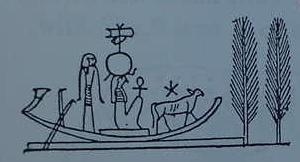Israel's Golden Calf is a deceased Pharaoh as a solar calf god?
29 May 2010 (Revisions through 4 June 2010)
I asked myself a very simple question regarding the Golden Calf that Israel worshipped at Mount Sinai:
"Do Egyptian myths ever make mention of a Golden Calf?"
The answer was yes!
Below, my "findings" on the Golden Calf from an Egyptian perspective (click on the blue underlined urls embedded in the below text for more pictures and commentary).
In some Egyptian myths the Sun rose each day from between two sycamore trees (Hathor and Nut as well as Isis being identified as a Sycamore tree) of Turquoise at Heliopolis (Biblical On). The sun was likened to a bull-calf as it arose at dawn, being born of Hathor the cow-goddess (a goddess of Turquoise and copper miners in the Sinai) who personified the sky giving birth to the sun. The sun at times appears in Egyptian art with the wings of Horus the hawk (known as "Horus of Bedhety"), who was assimilated to the sun. The sun was frequently portrayed as being ferried by a solar bark or boat across the heavenly Nile.
In the Old Kingdom Pyramid texts the deceased Pharaoh declares that "he _is_ A GOLDEN CALF_" and begs to be allowed to ride the solar bark for all eternity with the sun-god Re or Ra and Horus. Other Pyramid texts portray the deceased Pharaoh as an imperishable Polar Star in the heavens. So the below scene of a bull-calf with a star over its back may be an iconographic representation of Pharaoh as THE GOLDEN CALF _and_ the "Imperishable Pole Star."
Dr. Pinch PhD (Emphasis mine):
"The idea of the king as the nursling of the divine cow is at least as old as the Old Kingdom, since he is described as 'The Calf of Gold' and is told 'Your mother is the great wild cow who lives in el Kab. She will nurse you."
(Pyramid Text 729a. cf. p. 175. "The Cow and marsh motif." Geraldine Pinch. Votive Offerings to Hathor. Griffith Institute Ashmolean Museum, Oxford. 1993)
Another Old Kingdom Pyramid Text, apparently (?) of Pharaoh Pepi I (2321-2287 BC) or Pepi II (2278-2184 BC):
"Pepi comes to thee, O Ra, a calf of gold, born of heaven. I have come to
you Ra, a calf of gold born in the sky, a fatted calf of gold...O Horus, do
not leave me boatless." (Pyramid text Utterance 485a)
Could the biblical injunctions against Calf worship and the planting of an asherah tree near Yahweh's altar be a clue that in the Late Bronze Age, the Canaanites assimilated Egyptian solar beliefs and motifs to the worship of the Canaanite high god, El and later to Yahweh? If I am correct in identifying the "Golden Calf" with the Sun at dawn, then some sense can be made of Israel's declaration that the "Golden Calf" led Israel up out of Egypt to Mount Sinai, not Yahweh (Exodus 32:4). That is to say, in leaving Rameses (Tell Qantir and Tell ed-Daba?), Israel was following the Egyptian turquoise/copper miner's track to the southern Sinai. In the wilderness they would take their morning bearings from the Sun's rise and movement (rising in the East as "the golden bull-calf" and moving to the South) which would invariably bring them to Mount Sinai, which is _traditionally_ located ESE of Goshen and Rameses (Faqus and Tell Qantir/ed-Daba). This Egyptian miner's route would also take them near the temple of Hathor, patron-goddess of the Egyptian miners, who in myths was also a cow-sky-goddess who gave birth each morning to the Sun as a solar bull-calf.
The below drawing shows the god solar Horus with a hawk's beak seated with a Solar disc representing the sun atop his head with a boat's sail. Accompanying Horus is a male calf with a five-pointed star above its back. The Old Kingdom Pyramid Texts reveal that the deceased pharaoh was sometimes envisioned as being an imperishable Pole Star in the heavens as well as being a Golden Calf which rides a solar bark or boat across the sky with Horus. In myth the solar calf as the sun rises at dawn from between two mythical sycamore trees made of turquoise at On (Heliopolis) which were symbols of the cow goddess Hathor/Nut.
Below, the Solar/Sun-boat/bark with Horus seated with hawk head, and sun disk. Before him is a star, a bull calf, and two scyamore trees. (cf. Vol.12. p. 36. figure 22. Louis Herbert Gray. The Mythology of All Races, Egyptian and Indo-Chinese. Boston & Oxford. Marshall Jones Company. 1918).
Unfortunately Gray does not identify the source for the above drawing. But the "stick-figure" rendering of the Solar Bark's pilot resembles similar renderings of scenes from the Egyptian funerary text known as The Book of the Dead, which depict the 24 hour course of the Sun-god in the underworld as well as heaven in his solar bark which rides a heavenly as well as underworld Nile, said scenes appearing in 18th Dynasty tombs like Thuthmose III, ca. 1540-1450 BCE, cf. below, where the deceased Pharaoh is being suckled by a tree-goddess identified with Isis (cf. p. 108. "Thuthmosis III." Peter A. Clayton. Chronicle of the Pharaohs, The Reign-by-Reign Record of the Rulers and Dynasties of Ancient Egypt. London. Thames & Hudson. 1994). Note: Some Conservative Protestant scholars opt for an Exodus ca. 1446 BC on the basis of 1 Kings 6:1. This date is well-after the Old Kingdom Pyramid Texts identifying the deceased Pharaoh with a Golden Calf and the solar-bull-calf of dawn.
